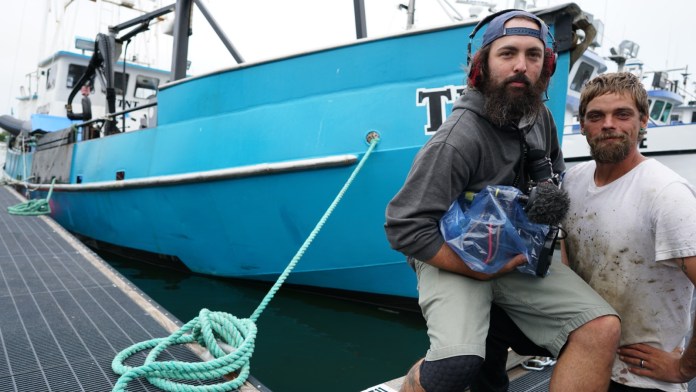
 If you like fishing, adventure or just enjoy a good reality binge, add Battlefish to your Netflix queue. Filmed out of Illwaco, the show follows four commercial fishing rigs during the 2017 tuna season. Each boat is featured with its own backstory and is followed by an individual cameraman for the duration of the season. The TNT, manned by captain Karl Travenshek and deckhands Thomas Bell and Thor Anderson, had a great season. “It’s a big producing boat,” explains Thomas of the schooner nicknamed ‘the blue canoe’ by its crew.
If you like fishing, adventure or just enjoy a good reality binge, add Battlefish to your Netflix queue. Filmed out of Illwaco, the show follows four commercial fishing rigs during the 2017 tuna season. Each boat is featured with its own backstory and is followed by an individual cameraman for the duration of the season. The TNT, manned by captain Karl Travenshek and deckhands Thomas Bell and Thor Anderson, had a great season. “It’s a big producing boat,” explains Thomas of the schooner nicknamed ‘the blue canoe’ by its crew.
Thomas’s career didn’t start on the TNT tuna fishing. His greenhorn year was spent on the Lady Laura Dungeness Crab boat. “It started a little bit rocky until I got the hang of it.” He describes the season as crazy, runs would take the crew out for days or weeks at a time and deckhands had to be on point for 36-48 hours straight. Thomas fished the crab season for six more years and grew to enjoy the pressure. “I’m an adrenaline junkie plus its a decent pay day. You see how far you can push your body to the limit.”
Tuna, though, Thomas notes, is a different ballgame. As opposed to the rapid pace of Dungeness; albacore can take four or five hours of tacking to get a bite. Once it begins, however, the pace is brisk, throwing and unhooking fish with speed and precision. Both jobs are physically demanding and take a lot out of you, but, the plus side of albacore, Thomas mentions is, “Tuna sleep at night.”
On any commercial fishing boat, bonds are formed between workers on the long hours spent aboard. “Even when you’re upset you can’t get away, it helps grow the relationship,” Thomas explains. His mates on the Lady Laura and the TNT became like family over the years.

Photo credit: Thomas Bell
Photo credit: Thomas Bell
This clan of fishers have to have certain skills and traits, too. A strong work ethic, a positive attitude and a wisecracker are a good start. When Netflix came looking for boats to follow on their seasonal adventures, they were looking for a crew to portray these attributes, and to be their true selves on film. “But how much?” Thomas laughs, the crew were unsure as to how the station would take their straightforward, crass, take it or leave it attitude. “We cuss like crazy.”
Turns out, Netflix was on board, truly. The TNT was chosen from the boats who interviewed and a cameraman was added to the crew. Equipped with GoPros, sound equipment, a drone for overhead shots and a main camera, Kyle Haggerty was assigned to follow Karl, Thor and Thomas all day everyday. “He was very conscious of space, but we had to act like he wasn’t there, that was a challenge in itself,” Thomas recalls. After experience on Pilgrim Media Group’s show, Wicked Tuna, Kyle was used to the industry. His role was everything rolled into one. He did the interviews, shot scenes, worked the sound, lighting and decided on camera angles and views.
The show highlights the struggles and challenges of having your livelihood depend on the whims of nature. Some days the boats brought in over one hundred fish, anything in triple digits is the goal. Other days the boats failed to find any schools. Boats trail between eight and sixteen jigs behind, enticing the fish to bite. The captain chooses a tack to drive, following it back and forth repeatedly waiting for fish. These routes can range up to a mile and are chosen based on water charts, instinct and observation. If the team spots a flock of birds hovering and diving, they know fish aren’t far below. Once tuna start to bite, the pace is wild. Each boat has different methods for catching fish and storing them. The TNT stores the catch on board in a blast freezer. The temperature stays at -27 to -30 degrees in the hold, so the boat can remain on the water for about two weeks, or until the hold is full. On the other hand, the Oppor-tuna-Ty, another boat featured in Battlefish uses a different tactic. Each day the speedy vessel treks in and out of the docks and brings back fresh fish. The catch is then shipped to nearby stores and markets and sold at a higher price.
The 2017 season with the TNT was Thomas’s last on the water. In January of this year he and his wife Sara moved to Grass Valley, California. Of course he misses the adrenaline and the time with his friends and “nautical family”, but mostly he misses the ocean. “You fall in love with it,” he says. Fortunately, there are major benefits to being a landlubber. “We’re here everyday with each other,” he says of his wife. “And I sleep in my own bed every night.”

Photo credit: Thomas Bell
When the show was released in September 2018, Thomas and Sara were excited to see it. Overall, Thomas says, it was an honest portrayal of the crew’s life on the TNT. “We just act kinda goofy, and it shows that.” Silly and serious, intense and laid-back, the show takes the highs and lows of the job and bundles them up for viewers. We get to experience the thrill of the catch from our living room.











